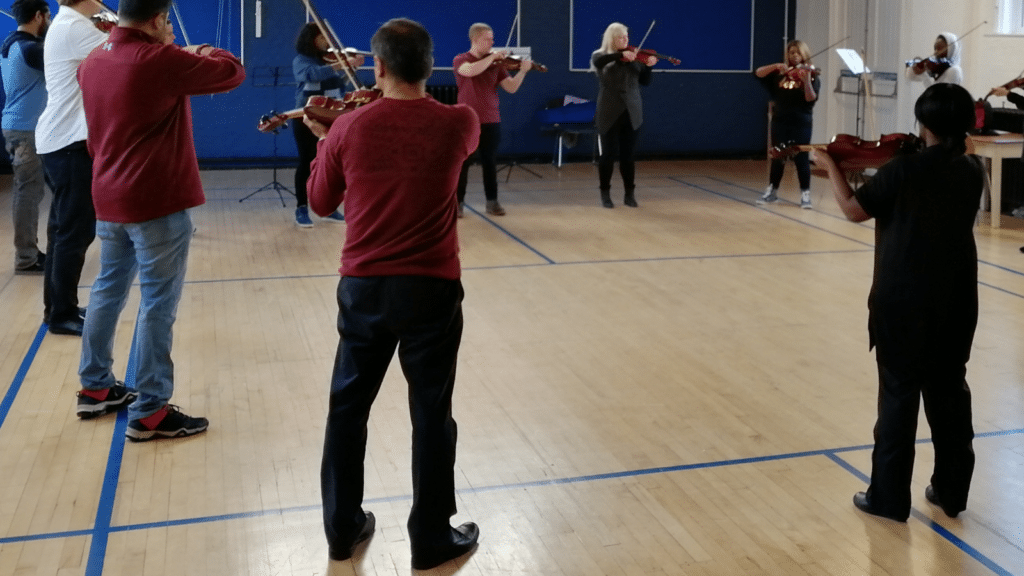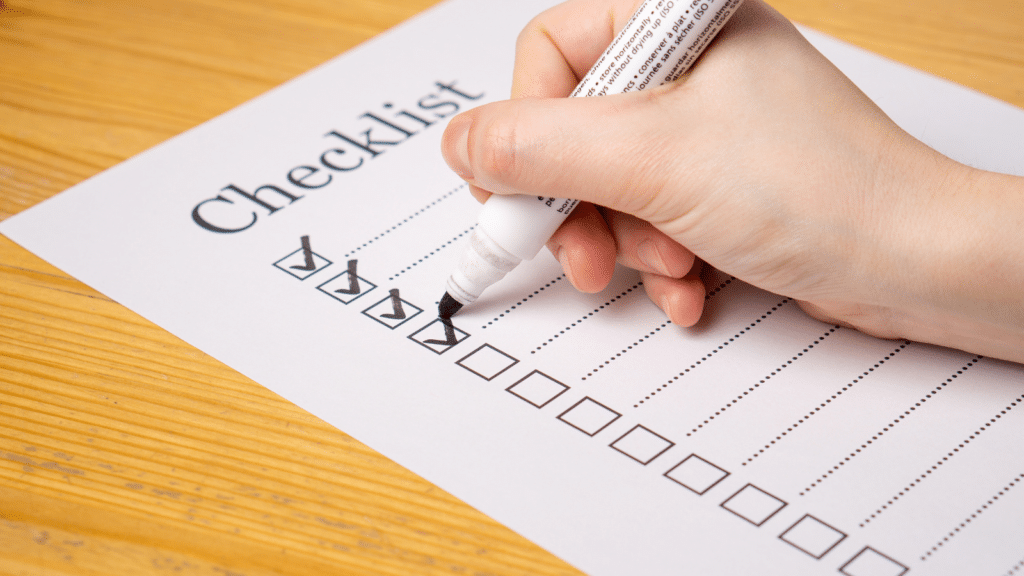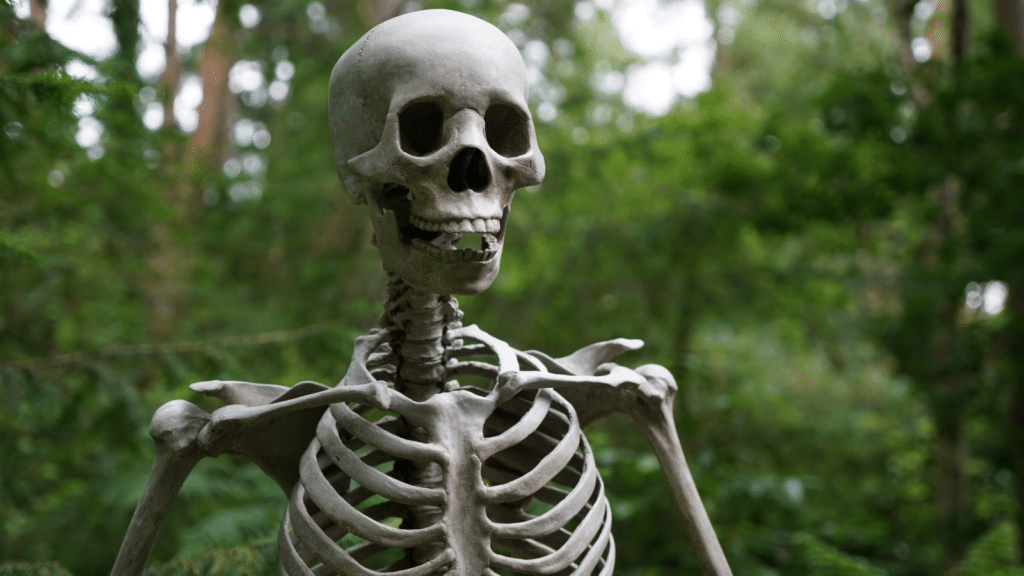There's a fascinating moment in many of our Beginner Violin Classes where I shout 'FREEZE', and everyone suddenly stops moving. Then, to much hilarity, I point out that every single person in the room is bending around to the left!
Faces are turned towards the violin, eyes are locked down in an intense stare, and everyone is looking directly at the bow/string contact point or the left hand fingers.
Everyone's eyes - and everyone's attention! - have turned to where the most compelling action is!
But what effect does this have on our playing?
Unnecessarily bending and turning to the left isn't great for violin playing. Even just staring at your left hand or bow whilst playing can lead you to twist your head and neck too. Ouch!
Unnecessary tension will start to creep in, your neck will begin to ache, and other parts of your body movement will start to seize up.

If your whole mental focus follows your gaze, you'll end up with the left side of your body taking up 100% of your attention. There'll be no spare space in your brain for checking that your body posture is correct!
For clear, easy sound production, our body posture and right hand technique must be relaxed, well-balanced and correctly positioned. So having that spare capacity isn't just important, it's actually essential.
So why do we get distracted?
Our primeval 'fight or flight' responses demand that we give fullest, fastest focus to our most difficult challenge at any given moment.
This is why our subconscious memories kick in: they allow us to respond to challenges faster than the speed of thought!
But the unique complexity of violin playing means that the immediately obvious solution isn't always the right one.
Yes, we need to rely on fast instinctive reactions... but those instincts are themselves based on carefully thought out, well-drilled behaviours, which in turn can be very counterintuitive!
Whoa...! This is the point where many people start to think: "this violin thing is really difficult!".
But it doesn't have to be that way.
There are two precautions you can take in advance which will make it MUCH easier to tackle complex violin-playing problems:
1) Practise the fundamental body movements carefully and conscientiously so that they're drilled deeply into your muscle memory. Then...
2) Take the time, EVERY time you're about to play, to make sure all the fundamental balances of the body are correctly set in place BEFORE you start...
...If you do these two things, then you'll start playing with a clear head... and will be able to focus on the other challenges ahead of you!
But when there's so much else to think about, how can you develop the discipline to remember to do these two things?
The solution, as ever, is having a checklist - and remembering to use it!

Firstly we must insist upon getting our fundamental body positions in place BEFORE we start to play. Use ViolinSchool's 3 Important Checklists to make sure that each part of the body is in the right position.
Secondly, we need to remember to check in regularly whilst playing, to make sure they haven't shifted.
THEN we stand the best chance of keeping a good balance, and therefore optimising our sound production as we play!
It's worth reiterating how important that second principle is - of checking the body position regularly whilst playing.
You see, it's not enough just to make sure your body is correctly positioned before you play - crucial as that is.
Because as you play, your body movements will gradually wear down the integrity of your posture. This creates inefficiency in your other technical movements.
You might start with the best of intentions, but as other challenges begin to take up your focus and attention, you have a stream of other things to think about, so you forget about your posture.
The solution to this is to actively reset your posture on a REGULAR basis as you play. You need to take time out from that shiny new finger technique or that difficult bowing motion, in order to check that the fundamentals are still correctly in place!
But this goes against our human nature. What's urgent often takes the place of what's important. But we can’t afford to allow that here!
Even if it feels wrong, we violinists need to develop enough discipline to make sure that the fundamentals of good body posture are always in place... whatever the cost!

Getting a trick or a technique right at the expense of your core posture or bowing technique might feel like an achievement at the time. Indeed, for a few minutes in a larger practice session, it could be the right thing to do.
But if you repeatedly ignore your body position and posture in order to focus on technical details, then in the long term it will lead to frustration.
Inconsistencies in body movement and core left and right hand positions will ultimately set the body off balance. And this will undermine much of the good work you've done on the details of your violin technique, by introducing inefficiencies and unnecessary tensions into your physical movements.
So... if you find your eyes moving to the left, that's fine for a moment or two, but don't let them stay there! Keep yourself focused on the tasks ahead, and use a clear checklist to give you the discipline you need to stay alert to EVERYTHING that matters... not just what seems most urgent!
Use ViolinSchool's 3 Important Checklists to help you check your posture and body position before you start to play:
Please visit our sponsors:
London String School - Tuition for Adult Learners in London
MusicLand - Creative Music Products for Teachers and Learners
Please visit our sponsors:
FiddlerShop.com - Quality instruments at an affordable price
London String School - Tuition for Adult Learners in London
MusicLand - Creative Music Products for Teachers and Learners
